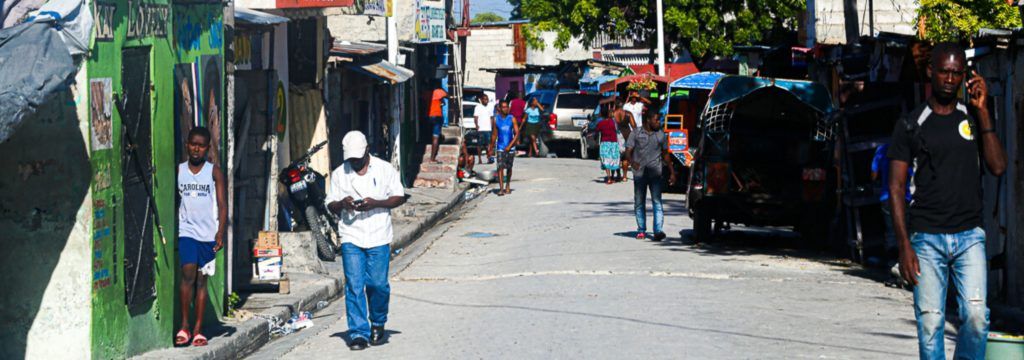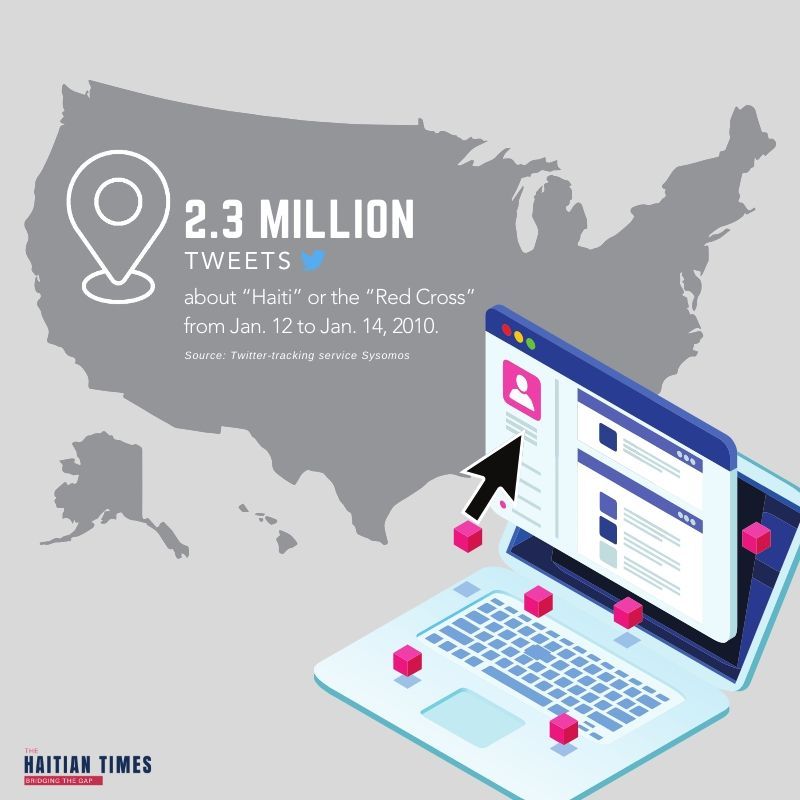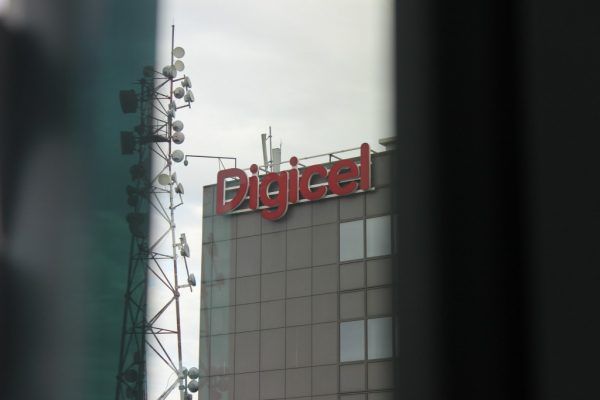The 2010 earthquake severed many traditional lines of communication in Haiti. It toppled cell phone towers, damaged a major fiber-optic cable, knocked television and radio stations off the air and made telephone communication via landlines nearly impossible.
Diaspora members had to change the way they communicated and gathered information in the days following the disaster.
“The earthquake became this pivotal moment where we had to use social media for information,” said Leonie Hermantin, who serves as director of development, communications and strategic planning at the Sant La Haitian Neighborhood Center in Miami.
Social media became a source of mutual support for Diaspora members attempting to keep pace with news and check in with loved ones, as people shared posts through Twitter and large Facebook groups. And in the years since the earthquake, social media has played a bigger and bigger role as an information-sharing tool for Haitians and the Diaspora, thanks to the changing telecommunications landscape in Haiti and the growing popularity of platforms like Whatsapp.
Although social media platforms have made communication easier, they have also, by rapidly spreading both facts and, at times, rumors, had an impact on social and political life in the 10 years following the earthquake.
Communicating after the disaster
For 48 hours after disaster struck, most of Haiti lacked cell service. The country’s two largest telecommunications providers at the time, Digicel and Voila, had placed most of their cell towers on top of buildings, leaving them susceptible to damage, said Charles Edouard Denis of Petionville, who served as an assistant vice president for the former Haitian telecommunications company Haitel, from 1999-2007.
Even after the 48-hour outage, cellular communication was unreliable.
“It took them a while to (restore) the network. However, with all of these people trying to make calls, the network kept shutting down, because of the amount of traffic,” Denis said.
The internet proved to be the most reliable method of communication. While the earthquake damaged the undersea fiber-optic cable connecting Port-au-Prince to the Bahamas, many of Haiti’s internet service providers (ISPs), were using satellite infrastructure. Two of the most popular ISPs, Access Haiti and Hainet, used a microwave internet connection to the Dominican Republic.
Those lucky enough to have internet access at the time communicated with loved ones through home internet or free voice-over internet protocol (VoIP) services offered by Access Haiti and Hainet after the earthquake.
“Everybody was helping everybody else, that’s how we got out of that situation,” Denis added. “If one person in one neighborhood had access, almost everyone in that neighborhood was either inside that yard or behind the walls.”
Rachele Viard, who currently works for the Haitian Times, was living in Haiti with family during the earthquake and experienced this spirit of mutual aid herself. While the earthquake destroyed the home Viard was staying in with her mother, she managed to salvage her laptop.
After sleeping outside for a few nights, Viard, who was 21 at the time, traveled to her uncle’s house in Petionville, where she charged her laptop and logged into Facebook and Twitter. Viard said her uncle had fuel and a generator to power his internet connection.
“I Facebooked all of my family members and other relatives and people I hadn’t talked to on the phone, and I let them know that I was OK,” Viard said.
Social media eventually became her lifeline for getting out of Haiti. Through Twitter, she established a connection with her father in Florida, who was involved in relief efforts.
“He found a plane and got me some information on this guy who he was working with the Red Cross and said, ‘look for this guy who’s going to be at the airport … that’s going to be your ticket to Florida,’” said Viard.
After meeting up with the aid worker, Viard flew to the United States on a private flight, with little else but the clothes on her back.
Social media’s continued growth
In the U.S., Viard’s father was one of many Haitians using social media to communicate with loved ones, locate missing people and learn about relief efforts.
Although many communication lines in Haiti were gradually restored following the earthquake, Facebook and Twitter were used extensively in the rescue effort. Through Twitter messages and Facebook groups, Diaspora members shared the locations of family members and made requests for anyone in a given area to check in on them, according to Hermantin.
Many posts were not even directed at a single person. “There was a lot of sharing of posts, sharing of information and attempts to help even one person that was missing,” she added. “People became extremely dependent on each other to share information through Facebook.”
Social media listserves, including Sakapfet, also became important methods for locating family members. Large Facebook groups like Earthquake Haiti, as well as Twitter, were used to share donation links for relief efforts.
The Twitter tracking service Sysomos recorded 2.3 million tweets using the words “Haiti” and “Red Cross” from Jan. 12-14, 2010 alone.
Meanwhile, major news outlets like CNN shared video reports and Twitter posts from citizen journalists in Haiti. CNN also monitored tweets and created a webpage to list the most notable comments.
While the world witnessed the widespread use of digital technology and social media to document a major tragedy, local media also played a role in the U.S. and Haiti.
The handful of radio stations that remained operational served as the main source of news for Haitians in the days following the earthquake, said Diderot Musset, a Haitian citizen and general manager at the tablet manufacturing company Surtab, based in Port-au-Prince.
Many stations in Port-au-Prince were able to come back on the air five to eight days after the earthquake. While initial reports were limited to building damage and body counts as journalists tended to their families, more reporting on earthquake victims followed, according to a University of Miami study published in 2012.
In Miami, many turned to Haitian media, particularly radio, to learn about ongoing developments. Interviews conducted with 18 Haitians in the 10 days following the earthquake found that community members were generally satisfied with local Creole-language radio but wanted more information about family members, the study noted.
While community media still plays an important role, Whatsapp has since risen to prominence as a way of staying informed about events in Haiti, according to Hermantin.
She said the situation in Haiti always has a major financial and emotional impact on the well-being of Miami’s Haitian community, which Sant La Neighborhood Center serves.
“We get updates about what’s happening every day … so I’m definitely aware of what’s going on, depending a lot on Whatsapp messaging to get in-the-moment information,” said Hermantin.
On Nov. 20, the day Haitian President Jovenel Moise met with U.S. Ambassador Kelly Craft, Hermantin said she expected her organization to receive an update on the meeting, through Whatsapp users in Haiti with political connections.
Communication via Whatsapp is free for anyone with a smartphone and a mobile data plan. Currently, about 75 percent of Haitians 18 and older owns a smartphone that allows for internet access. In January 2019, 57% of the world’s population used the internet, according to a report published by We Are Social and Hootsuite. A slightly lower share – 52% of the global population – uses mobile devices to access the web.
In 2010, fewer than a million Haitians had access to a smartphone, Musset said, in a population of about 10 million people at the time. As a result, he said, social media was not as widely used as it is today to document breaking news events.
Since the earthquake, Digicel has taken on a larger role in providing mobile internet access. Digicel’s acquisition of Voila in 2012 and the collapse of Haitel in 2013 gave the company a 74% market share of subscribers. Natcom, which is now a major internet service provider, entered the mobile sector in 2011 as a competitor to Digicel, after purchasing a majority of the state-owned telecommunications company Teleco.
Digicel has benefitted from relationships other telecommunications companies did not have after the earthquake, including founder Denis O’Brien’s close relationship with Bill Clinton, who helped lead the recovery effort through the Clinton Foundation. Since 2010, Digicel has received millions of dollars from USAID. O’Brien has also served as chairman of the Clinton Global Initiative’s Haiti Action Network.
To increase market penetration, the major telecommunications companies subsidized smartphone purchases prior to 2015, Musset said. Since then, a growing market for refurbished and second-hand devices has increased smartphone use even further.
“People started importing refurbished devices from China or the U.S.,” Musset added. “They feel like it’s more affordable, and they go for it … everybody wants to have their access to social media.”
Haiti’s mobile telecommunications network is due for an upgrade. Digicel CEO Maarten Boute told the Haitian Times earlier this year that his company plans to complete a network modernization project that will provide 3G and 4G LTE access nationwide, by June of 2020.
The coming Digicel upgrade promises even faster data speeds and easier access to Whatsapp and Twitter, which Musset said are the two most popular social platforms in Haiti.
Haitians have used these platforms ubiquitously to get information about the ongoing anti-government protests. Musset said he is a member of two separate Whatsapp groups, where both professional and citizen journalists share news and learn how their neighborhoods may be affected.
“(The protests are) now part of our daily routine, and that side is mainly done on Whatsapp, trying to figure out where you can or cannot go on any given day,” Musset said in November.
In contrast to the days after the earthquake, Musset noted that Digicel has maintained service, even through the most heated days of protest. He also said people focused much of their communication efforts on finding loved ones in early 2010, as opposed to sharing news.
While she acknowledged that Whatsapp has done nothing to allay an already tense political situation, Viard said the increased access to information it provides is mostly a good thing for the country.
Musset shared some of her sentiments, saying that “it allows a lot of people that actually thought they were voiceless to feel like they have a voice.”
But he also said conversations over Whatsapp and Twitter can easily devolve into shouting matches, and sometimes carry rumors.
“It’s a problem because of fake news and how easy it is for someone to fabricate information and mislead people,” he also said.
Hermantin said Whatsapp has also carried misinformation that conjures up strong emotions. Some images, like those of U.S. troops landing in Haiti, are shared during peak crisis moments.
Typically, she uses Google to double-check the relevance and accuracy of images. While most people in Haiti can theoretically do the same, those with limited data plans might struggle, she said. Many of the top-selling plans in Haiti have set limits, including daily or monthly terms.
“Even the educated will believe almost anything they see on the internet,” Musset said. “You get fooled once or twice and you know not to systematically trust everything you read.”
According to Hermantin, certain community news sources can present more reliable alternatives to getting news through Whatsapp. She said sources like Island TV and WSRF radio in Miami, as well as Le Nouvelliste in Haiti, have journalists dedicated to verifying facts for their audiences.
While governments of developed nations like the U.S., United Kingdom and France have recognized the problem of fake news and even passed laws to limit it, Musset said the Haitian government has not taken steps to address its spread. The few fact-checking sites that exist, like T-Check Haiti, were started by private citizens.
In the divisive political climate that has gripped Haiti, personal biases have taken on an ever-increasing role in how people share and interpret information.
“Sometimes people believe what they want to believe, just like for (America),” Hermantin said. “They don’t need to verify the accuracy, because that’s what they want to believe.”


